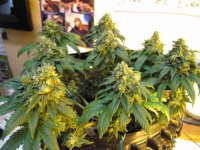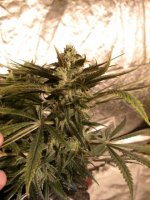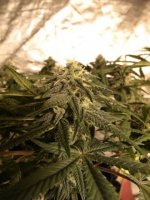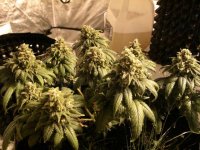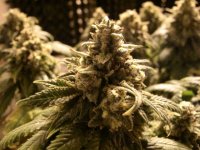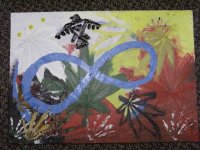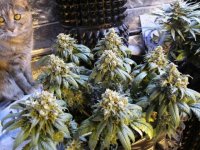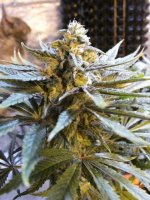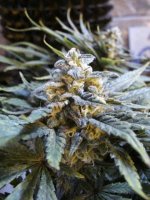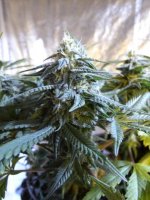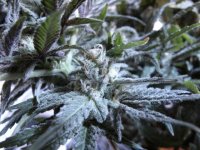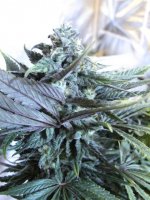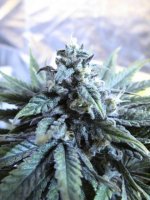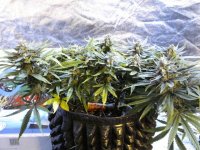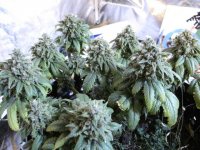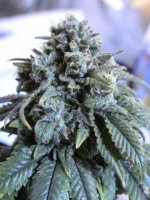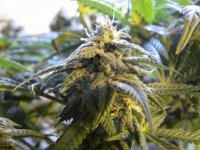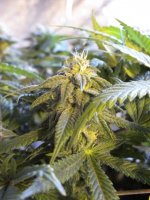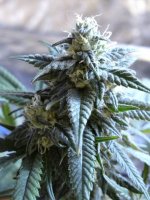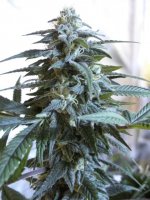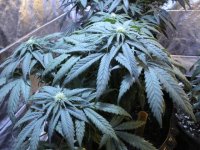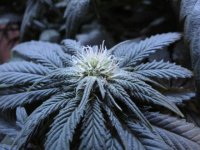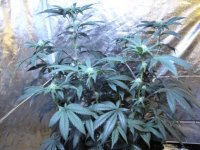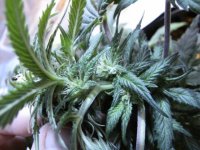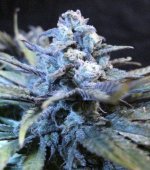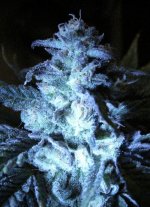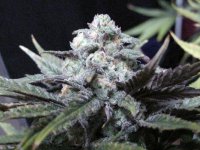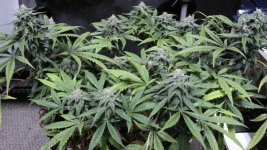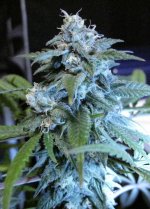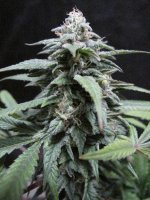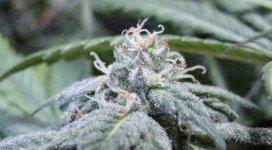chief bigsmoke
Active member
Roots
Source: Robinson Library: http://www.robinsonlibrary.com/science/botany/anatomy/roots.htm
The root is one of the first parts of a plant that starts to grow. A primary root develops from a plant's seed and quickly produces branches called secondary roots. At the tip of each root is a rootcap that protects the delicate tip as it pushes through the soil. Threadlike root hairs grow farther back on the root. These hairs greatly increase the plant's ability to absorb water and minerals from the soil.
Kinds of Roots
There are two main kinds of root systems -- fibrous and taproot. Grass is an example of a plant with a fibrous root system. It has many slender roots of about the same size that spread out in all directions. A plant with a taproot system has one root that is larger than the rest. Carrots and radishes have taproots. Taproots grow straight down, some as deep as 15 feet.
 Some plants have modified roots that perform special functions. Roots that grow from the stem above the ground are called adventitious roots. They include the prop roots of corn and certain other plants. Prop roots grow down into the soil from the lower part of the stem and help brace the plant agains the wind. Some species of orchids and other plants that live on tree branches send out aerial roots, which cling to the branches. Aerial roots absorb water and minerals from the surface of the tree and from the air. Mistletoe is one of the few plants with roots that penetrate the limbs of a tree. These roots, called sinkers, absorb food, water, and minerals directly from the tree.
Some plants have modified roots that perform special functions. Roots that grow from the stem above the ground are called adventitious roots. They include the prop roots of corn and certain other plants. Prop roots grow down into the soil from the lower part of the stem and help brace the plant agains the wind. Some species of orchids and other plants that live on tree branches send out aerial roots, which cling to the branches. Aerial roots absorb water and minerals from the surface of the tree and from the air. Mistletoe is one of the few plants with roots that penetrate the limbs of a tree. These roots, called sinkers, absorb food, water, and minerals directly from the tree.
 Parts of a Root
Parts of a Root
The Root Tip. A root grows in length from an area at its apex (tip). This growth area is called the apical meristem. A meristem is any part of a plant where the cells divide rapidly, forming new cells continually. The apical meristem is covered by the root cap, a thimble-shaped group of cells. The root cap protects the delicate root tip from damage as the root grows in length and the tip pushes through the soil.
The cells produced by the apical meristem are all small and nearly identical. In the region of elongation, the cells rapidly grow longer. Farther back lies the region of maturation, where the cells differentiate -- that is, take on a different structure and appearance according to their functions in the mature root.
The Outer Tissues. The outer layer of cells of a root is called the epidermis. It serves as a sort of skin and protects the tissues beneath. Tiny, hairlike extensions called root hairs grow from the epidermis. The root hairs absorb most of the water and minerals that a plant takes in from the soil.
A thick layer of rounded cells called the cortex lies just inside the epidermis. These cells contain stored food and water. The inner layer of cells of the cortex make up the endodermis.
 The Core, or stele, is the central portion of the root. Its outer layer of cells is called the pericycle. Inside the pericycle are two kinds of tissues, xylem and phloem. Xylem includes rows of dead, tubular cells called vessels, which conduct water and minerals up to the stem and leaves. Phloem consists largely of rows of long, living cells called sieve tubes. These cells transport food down from the leaves for use or storage by the root.
The Core, or stele, is the central portion of the root. Its outer layer of cells is called the pericycle. Inside the pericycle are two kinds of tissues, xylem and phloem. Xylem includes rows of dead, tubular cells called vessels, which conduct water and minerals up to the stem and leaves. Phloem consists largely of rows of long, living cells called sieve tubes. These cells transport food down from the leaves for use or storage by the root.
Secondary Tissues. All the tissues described above are known as primary tissues. Many plants that live just one year have only primary tissues in their roots. But other plants, especially those that live more than one year, have secondary tissues in their roots in addition to primary tissues. The growth of primary tissue adds to the length of a root. The development of secondary tissue adds to its thickness. Secondary-tissue growth produces the large, brown, woody roots in trees, shrubs, and other plants that live for many years.
Secondary tissues develop from two meristems. One, called the cork cambium, originates beneath the epidermis, generally in the pericycle. It produces cork cells and pushes them toward the outside of the root. As the cork expands outward, the endodermis, cortex, and epidermis die and peel off. The cork replaces them and becomes the outer covering of the root. The other secondary meristem, the cambium, lies between the primary xylem and the primary phloem. It produces secondary xylem cells toward the center of the root, and secondary phloem cells toward the outside.
Source: Robinson Library: http://www.robinsonlibrary.com/science/botany/anatomy/roots.htm
The root is one of the first parts of a plant that starts to grow. A primary root develops from a plant's seed and quickly produces branches called secondary roots. At the tip of each root is a rootcap that protects the delicate tip as it pushes through the soil. Threadlike root hairs grow farther back on the root. These hairs greatly increase the plant's ability to absorb water and minerals from the soil.
Kinds of Roots
There are two main kinds of root systems -- fibrous and taproot. Grass is an example of a plant with a fibrous root system. It has many slender roots of about the same size that spread out in all directions. A plant with a taproot system has one root that is larger than the rest. Carrots and radishes have taproots. Taproots grow straight down, some as deep as 15 feet.


The Root Tip. A root grows in length from an area at its apex (tip). This growth area is called the apical meristem. A meristem is any part of a plant where the cells divide rapidly, forming new cells continually. The apical meristem is covered by the root cap, a thimble-shaped group of cells. The root cap protects the delicate root tip from damage as the root grows in length and the tip pushes through the soil.
The cells produced by the apical meristem are all small and nearly identical. In the region of elongation, the cells rapidly grow longer. Farther back lies the region of maturation, where the cells differentiate -- that is, take on a different structure and appearance according to their functions in the mature root.
The Outer Tissues. The outer layer of cells of a root is called the epidermis. It serves as a sort of skin and protects the tissues beneath. Tiny, hairlike extensions called root hairs grow from the epidermis. The root hairs absorb most of the water and minerals that a plant takes in from the soil.
A thick layer of rounded cells called the cortex lies just inside the epidermis. These cells contain stored food and water. The inner layer of cells of the cortex make up the endodermis.

Secondary Tissues. All the tissues described above are known as primary tissues. Many plants that live just one year have only primary tissues in their roots. But other plants, especially those that live more than one year, have secondary tissues in their roots in addition to primary tissues. The growth of primary tissue adds to the length of a root. The development of secondary tissue adds to its thickness. Secondary-tissue growth produces the large, brown, woody roots in trees, shrubs, and other plants that live for many years.
Secondary tissues develop from two meristems. One, called the cork cambium, originates beneath the epidermis, generally in the pericycle. It produces cork cells and pushes them toward the outside of the root. As the cork expands outward, the endodermis, cortex, and epidermis die and peel off. The cork replaces them and becomes the outer covering of the root. The other secondary meristem, the cambium, lies between the primary xylem and the primary phloem. It produces secondary xylem cells toward the center of the root, and secondary phloem cells toward the outside.
Attachments
Last edited by a moderator:

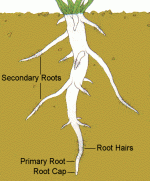






 I wish you all a very happy weekend. I hope you have even more fun than me.
I wish you all a very happy weekend. I hope you have even more fun than me. 